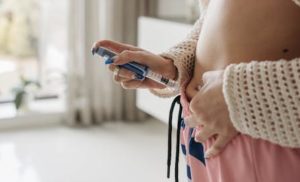 Insulin is a hormone produced by the pancreas. Insulin works to control blood sugar levels so that they are always at normal levels. Insulin injections are needed as a substitute for insulin in the body when the pancreas is unable to produce enough insulin, as is the case in patients with diabetes.
Insulin is a hormone produced by the pancreas. Insulin works to control blood sugar levels so that they are always at normal levels. Insulin injections are needed as a substitute for insulin in the body when the pancreas is unable to produce enough insulin, as is the case in patients with diabetes.
Insulin products in Malaysia are available in the form of vials or penfill. Patients will be supplied with insulin in the form of a penfill if they need to inject insulin by themselves at home. Penfill is used together with a pen-shaped device called an insulin pen that can be worn repeatedly. Not only that, there is also a disposable insulin pen in the form that is already filled with insulin inside.
Important tips for penfill-type insulin injections
 Among the main points to pay attention to for insulin injection is the insulin injection site. Patients are encouraged to inject insulin into the abdomen, as the absorption of insulin into the body is best in this area. In addition to the abdomen, other parts of the body that are suitable for insulin injection are the arms, thighs, and buttocks.
Among the main points to pay attention to for insulin injection is the insulin injection site. Patients are encouraged to inject insulin into the abdomen, as the absorption of insulin into the body is best in this area. In addition to the abdomen, other parts of the body that are suitable for insulin injection are the arms, thighs, and buttocks.
Insulin should be injected subcutaneously, that is, into the layer under the skin. Therefore, patients should use an appropriate needle size. Patients are advised to seek the advice of a doctor or pharmacist to choose the most suitable needle size.
Insulin that has just been taken out from the refrigerator and is about to be put in an insulin pen should be rolled between the two palms at least 10 times. This procedure is necessary to raise the temperature of the insulin and avoid pain while injecting cold insulin.
Following that, patients are advised to gently shake the insulin pen approximately 10 times to ensure that the insulin content in the penfill is uniformly mixed. This step is essential for ensuring that the insulin dose delivered is accurate and has the desired effect.
Another important thing to do, especially for insulin penfills that have just been put in the insulin pen, is priming. This step is done by setting the dose (at least two units) and then gently pressing the insulin pen knob until there is a drop of insulin coming out of the needle. Priming is important to remove air bubbles trapped in the needle or penfill and ensure that the insulin pen is working properly.
It is not recommended for patients to inject insulin at the same site each time. Injecting insulin in the same location can result in lipodystrophy, or the growth of tiny lumps on the skin. Lipodystrophy should be avoided since it decreases the absorption of insulin into the body.
Patients are also recommended to use a new needle for each injection. Repeated use of the needle blunts it, causing pain during the injection. There is also a risk of insulin hardening in the needle as a result of improper storage, which causes the needle to block. Using new needles can help to avoid this issue and guarantee that insulin is administered at the correct dose.
After completing the injection, the needle should be removed from the insulin pen. Patients should always take this step to prevent air and other contaminants from getting into the penfill. This step is also very important to prevent insulin leakage from penfill.
The appropriate way to store insulin
The patient should store unused insulin on the middle shelf of the refrigerator at a temperature of 2–8oC horizontally. Insulin should not be stored in the freezer or on the shelf at the refrigerator door. The act of opening and closing the refrigerator causes the temperature near the door to fluctuate. Patients are recommended to keep insulin in its original packaging, which includes the dose information on the label.
The insulin in use should be kept in a secure location at room temperature. Furthermore, insulin should be kept out of direct sunlight and out of reach of children.
If it is necessary to travel long distances, the patient should carry insulin in a cooler bag containing ice packs. Insulin should not be left in the vehicle. Unused insulin supplies should be transferred to the refrigerator upon arrival at the intended destination.
Ways of disposing of insulin needles
Insulin needles should be disposed of in a safe way. The patient can use a sealed container to discard the needle that has been used. The container used should always be tightly closed before being thrown into the trash. If possible, patients are encouraged to place warning labels on such containers, for example, “Sharp” or “Handle with care.” The needles should not be discarded with the rest of the litter. The patient’s conscientious behaviour can safeguard family members or cleaning workers from injuries caused by the needle’s prick.
The importance of proper insulin management and use
The proper insulin management and use are essential for optimal blood sugar level control. This can help patients reduce the risk of diabetes complications such as blindness, nerve damage, and kidney failure, as well as improve their quality of life. Patients can seek the advice of a doctor or pharmacist if they are still confused about how to manage and use insulin.
If there are any inquiries regarding medicines, please call the National Pharmacy Call Centre (NPCC) at the toll-free number 1-800-88-6722 during weekdays from 8 a.m. to 5 p.m., except on public holidays.

This article is written by Mohd Shahiri bin Abd Ghapar, a pharmacist at Pharmacy Practice and Development Division, Ministry of Health for Bahagian Amalan dan Perkembangan Farmasi (BAPF), KKM x The Malaysian Medical Gazette Series. It is hoped that this collaboration will help prpogate information regarding medication to the general public.
References:
- Persatuan Pendidik Diabetes Malaysia (2017). Forum for Injection Technique Malaysia FITMY. Retrieved May 5, 2021, from moh.gov.my.
- Ministry of Health (2015). CPG Management of Type 2 Diabetes Mellitus 5th Retrieved May 5, 2021,from www.moh.gov.my
- Bayu Galih Permana (2021). Mengenal 6 Jenis Insulin untuk Penderita Diabetes, Mulai dari Efek Samping dan Cara Penggunaannya. Retrieved May 5, 2021, from sehatq.com
- Nana Muhammad (2018). Perlu Lakukan Suntikan Insulin Sendiri Di Rumah? Ini Teknik & Cara Tepat Nak Buat. Retrieved May 5, 2021, from hellodoktor.com
- Pusat Rujukan Persuratan Melayu. dbp.gov.my
